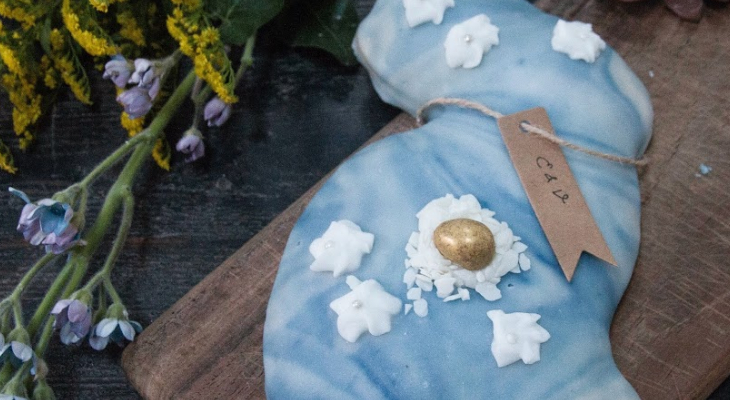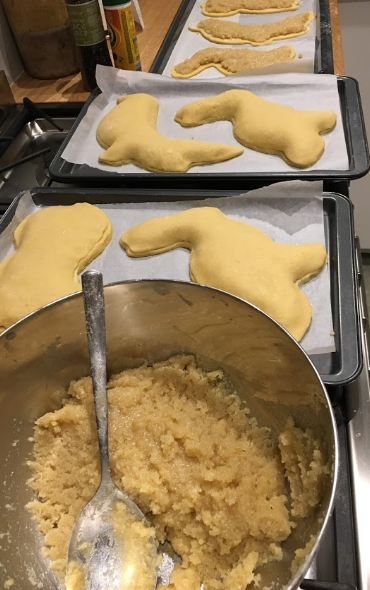Veteran food writer Karmen Tedesco speaks about the origins of this family favourite.
After the heady excesses of Christmas, Easter can sometimes feel like an anti-climax. There is no tree, no rushed unwrapping of secret surprises and very little singing. But there is one sweet which makes the lack of gifts worthwhile, colouring the religious feast with jewel tones and imbuing it with the joy of spring: the Maltese Easter biscuit bake, known as the figolla.

Sarah Micallef
“There won’t be Easter without a figolla,” veteran food writer – and television personality – Karmen Tedesco smiles. “And, despite our adoption of the English Easter egg, this almond-based biscuit remains an important part of our celebrations.”
The sweet pastry bake comes in two forms: one single-layered confection, covered in chocolate, white or pastel icing, and topped with half a chocolate Easter egg; or, the more popular, and “tastier” version, according to Karmen, consisting of a biscuit sandwich with a heart of pure almond marzipan, also decorated with a colourful glaze, or chocolate layer, and boasting a chocolate egg on top. “It must be a pure almond filling, and not an almond substitute – you will taste the difference immediately. Most confectioneries of good repute will make sure of this, though you should ask if you’re not certain,” Karmen advises.
The idiosyncratic forms which shape the traditional figolli give as much joy as that first, crunchy bite. Biscuit butterflies, springtime baskets, rabbits and even doves, in recognition of the confection’s connection with Easter, line the racks at some of the island’s most popular bake shops, and take pride of place inside the home. For no Maltese household would be complete this time of year without at least one, half-eaten, much-loved figolla.
And, indeed, it has been so for over 200 years. “The earliest known recipe for figolla appears in the first documented Maltese recipe book in the 18th century. This was published at around the same time when sugar started to be imported into Malta, so that might have had something to do with it, though the confection could have also been made with honey,” Karmen explains.
In all likelihood, the bake is a Sicilian import, she continues, a product of cultural exchange between the small island and Italian shores. Indeed, “the word comes from the Italian figura or figurina, which means figure or form and, like much else in Malta, it must have come from contact with other cultures,” she continues.
The first iterations came in the form of a man or woman, with a red-dyed egg on top. But, between the First and Second World Wars, this was replaced by the ever-popular chocolate egg, though the shape and form of the bake continued to evolve. “After 1945, there was even a three-dimensional figolla, in the shape of a lamb, topped by a little red flag, with a white cross, which represented the risen Christ. This was very popular for a number of years, but you hardly see it anymore, unfortunately. However, you can still buy the shapes and make them yourself by sticking two figolli together!” Karmen says.
The confection is one which is firmly embedded in the heart of the Maltese home, and the true spirit of Malta’s figolla lies in its connection with familial traditions, as generations of islanders pass their recipe on from mother, to daughter, to granddaughter, connecting families with the wider community. “They’re actually not difficult to make,” Karmen asserts. “You have to be gentle with the pastry – since it’s sweet and very delicate – and you can work it all by hand. You don’t even need a food processor,” she continues. But it’s the pure almond filling which is a core element in the success of a great figolla – and something which must not be compromised on, according to Karmen. Once all the prep has been completed, kids – even as young as four or five – can get stuck in, with a rolling pin and imagination to hand.
“I actually make them with my grandchildren today,” Karmen smiles. “I make the batches of pastry the evening before, and I give them some to roll out and shape themselves. We make all sorts of fantastic shapes! We finish the decorating on Maundy Thursday, but they are not allowed to eat them until Easter Sunday morning. That is the tradition,” she laughs.
Custom further dictates that these much-loved treats are taken by the children to be blessed during the procession of the Risen Christ (known locally as L-Irxoxt), which still takes place in various parishes around the island, such as Rabat, Bormla, Birgu, Mosta and Valletta. “Usually, this blessing takes place early in the morning of Easter Sunday, so the children – and, today, even adults – can then eat the sweet to their heart’s content.”
For the figolla is not just for kids. Its crumbly texture, crunchy biscuit sandwich and sweet icing is a perennial favourite with adults too, taking them back to moments spent with loved ones in the spring Easter sun. The bake does not last long in any household (though they can actually keep for three or four weeks), but the memories of a bite, downed with a strong cup of tea, are (just) enough to keep us looking forward to next year.

Sarah Micallef
Karmen Tedesco’s figolla recipe
Ingredients:
For the pastry
400g self-raising flour
100g margarine (or butter)
100g sugar
2 eggs
Orange rind
1tbsp of water
For the filling:
200g pure, ground almonds
100g sugar
125ml water
For the icing:
150g icing sugar
1tbsp (heaped) bitter cocoa powder
1-2tbsp warm water
¼tsp margarine
1tbsp of alcohol (bénédictine, rum or brandy)
Method:
1. For the pastry, mix the margarine and flour in a food processor or mixer. You can even use your hands. Whisk together the eggs, sugar and orange rind. Add this to the flour mix to form a soft dough. If necessary, add a bit of water. Leave the dough to rest for 15 minutes.
2. For the filling, add the sugar and water in a saucepan, and place it on the hob, heating it up until it dissolves. Bring to the boil and remove from the heat immediately. Add the ground almonds and stir well.
3. Preheat the oven to 190-200°, or 170-180°, fan-assisted, or gas mark 5-6.
4. Place the dough on baking parchment and cut out two shapes of the same size. Prepare a floured oven tray. Place the first shape on the tray and spread the almond paste on it, sandwiching it with the second shape.
5. Put the tray with the figolla in the oven for 25-30 minutes. Once cooked, take it out, letting it cool on the cooling rack.
6. In the meantime, prepare the icing. Mix the icing sugar and cocoa powder. Add a tablespoon of warm water to the margarine and add it to the sugar-cocoa mix. Add the alcohol and, if necessary, another tablespoon of warm water. Place the icing on the cooled figolla immediately. If the icing cools and goes hard in the bowl while you’re working, place it on a pan with hot water (bain-marie style) till it becomes soft and manageable again.
7. Finally, decorate your figolla with colourful icing and half an Easter egg.